A Census of Federally Regulated Big Cat Populations within the United States as of December 2020
Abstract
:1. Introduction
2. Materials and Methods
3. Results
3.1. Data Range
3.2. Federally Regulated Businesses Holding Big Cats
3.3. Big Cat Population Distributions
3.4. Tiger King Animals
4. Discussion
4.1. Data Accuracy and Specificity
4.2. Data Limitations
4.3. Historical Context
4.4. Population Observations
4.5. Population Trend Validation through Rescue Records
4.6. Geographic Observations
4.7. Tiger King Animals
5. Conclusions
Funding
Institutional Review Board Statement
Informed Consent Statement
Data Availability Statement
Acknowledgments
Conflicts of Interest
References
- Goode, E.; Chaiklin, R. Tiger King: Murder, Mayhem, and Madness; Netflix: Los Gatos, CA, USA, 2020. [Google Scholar]
- International Fund for Animal Welfare. Big Cats in Captivity Rescue and Advocacy—United States. Available online: https://www.ifaw.org/projects/big-cats-in-captivity-rescue-and-advocacy-united-states (accessed on 16 July 2021).
- The Wild Animal Sanctuary. The Wild Animal Sanctuary: Major Programs. Available online: https://www.wildanimalsanctuary.org/major-programs (accessed on 16 July 2021).
- Brulliard, K. The Trouble with Tigers in America. Available online: https://www.washingtonpost.com/graphics/2019/investigations/captive-tigers-america/ (accessed on 12 July 2019).
- The Humane Society of the United States. Big Cat Incidents (Publication). Available online: https://www.humanesociety.org/sites/default/files/docs/captive-big-cat-incidents.pdf (accessed on 20 June 2021).
- Nyhus, P.; Tilson, R.; Tomlinson, J. Dangerous animals in captivity: Ex situ tiger conflict and implications for private ownership of exotic animals. Zoo Biol. 2003, 22, 573–586. [Google Scholar] [CrossRef]
- Ahistus, J.; Vacco, K.; Long, S. (Eds.) Cheetah Acinonyx Jubatus Animal Management Program: Population Status and Breeding Recommendations (Rep.); Zoological Association of America: Punta Gorda, FL, USA, 2020. [Google Scholar]
- Goff, D.; Morris, C. (Eds.) Felid TAG Annual Report 2019 (Rep.); Association of Zoos and Aquariums: Silver Spring, MD, USA, 2019. [Google Scholar]
- Goff, D.; Morris, C. RCP Updates and News; Felid TAG: Omaha, NE, USA, 2019. [Google Scholar]
- Powell, D.M. Collection planning for the next 100 years: What will we commit to save in zoos and aquariums? Zoo Biol. 2018, 38, 139–148. [Google Scholar] [CrossRef] [Green Version]
- Richard, H. Zoo and Aquarium All Hazards Partnership. Connect. Available online: https://www.aza.org/connect-stories/stories/zoo-aquarium-all-hazards-partnership?locale=en (accessed on 20 June 2021).
- Garner, R. How Many Zoos Are There in the United States? Available online: https://www.whyanimalsdothething.com/how-many-zoos (accessed on 21 June 2021).
- Association of Zoos and Aquariums. AZA Statement on Michigan’s Large Carnivore Act (Press Release). Available online: https://www.aza.org/aza-news-releases/posts/aza-statement-on-michigans-large-carnivore-act?locale=en (accessed on 20 June 2021).
- Traveling Animals/Pub. Safety Protection Act, H. 594, 2021–2022 Session. Available online: https://webservices.ncleg.gov/ViewBillDocument/2021/50287/0/DRH40370-MH-122 (accessed on 20 June 2021).
- Traveling Exotic Animal and Public Safety Protection Act, H.R.2863, 116th Congress. Available online: https://www.congress.gov/116/bills/hr2863/BILLS-116hr2863ih.pdf (accessed on 20 June 2021).
- Big Cat Public Safety Act: H.R. 263, 117th Cong. Available online: https://www.congress.gov/117/bills/hr263/BILLS-117hr263ih.pdf (accessed on 20 June 2021).
- Captive Wildlife Safety Act of 2003, 16 USC 3371. Available online: https://www.fws.gov/le/pdf/PL108-191_CWSA.pdf (accessed on 20 June 2021).
- Licensing and Registration Under the Animal Welfare Act; Animal and Plant Health Inspection Service: Washington, DC, USA, 2019.
- List of Active Licensees and Registrants 2021 [XLSX]; United States Department of Agriculture: Washington, DC, USA, 2021.
- Garner, R. Who Are the USDA Class C Exhibitors? 22 November 2017. Available online: https://www.whyanimalsdothething.com/who-are-the-usda-class-c-exhibitors (accessed on 21 June 2021).
- Wenzel, J. Where Are the Tigers from “Tiger King” Now? Many of Them Live in Colorado, Just 45 Minutes from Denver. The Denver Post. Available online: https://theknow.denverpost.com/2020/04/01/tiger-king-animals-now-colorado-wild-animal-sanctuary/236586/ (accessed on 16 July 2021).
- United States Department of Justice. U.S. Government Seizes 68 Protected Big Cats and a Jaguar from Jeffrey and Lauren Lowe (Press Release). Available online: https://www.justice.gov/opa/pr/us-government-seizes-68-protected-big-cats-and-jaguar-jeffrey-and-lauren-lowe (accessed on 20 June 2021).
- Stark v. Adm’r, Animal & Plant Health Inspection Serv., No. 20-2024 (S.D. Ind., U.S.A 5 Aug 2020). Available online: https://www.peta.org/wp-content/uploads/2020/08/2020-08-05-Tim-Stark-v-APHIS-Order-Appeal-Dismissed.pdf (accessed on 20 June 2021).
- People for the Ethical Treatment of Animals. PETA Seizes 22 Big Cats from Tim Stark’s Roadside Zoo ‘Wildlife in Need’. Available online: https://www.peta.org/media/news-releases/peta-seizes-22-big-cats-from-tim-starks-roadside-zoo-wildlife-in-need/ (accessed on 21 June 2021).
- The Wild Animal Sanctuary. Wildlife in Need; The Wild Animal Sanctuary News Winter: Keenesburg, CO, USA, 2020; pp. 7–27. [Google Scholar]
- Turpentine Creek Wildlife Rescue. Animal Rescues. Available online: https://www.turpentinecreek.org/rescues/ (accessed on 21 June 2021).
- The Wild Animal Sanctuary. The Final Chapter for Tiger King Facility; The Wild Animal Sanctuary News Winter: Keenesburg, CO, USA, 2020; pp. 30–47. [Google Scholar]
- In the matter of the Search of the Subject Premises 21619 Jimbo Road, 21469 Jimbo Road and 21371 Jimbo Road, Thackerville Oklahoma 73459 and Seizure of Specified Animals Identified Therin. Seiler Aff. ¶12. (E.D. Okla., U.S.A, 12 May 2021). United States. Available online: https://www.justice.gov/opa/press-release/file/1395796/download (accessed on 21 June 2021).
- Chavira, D. ‘We Have The Room’: Colorado’s Wild Animal Sanctuary Takes in 35 Wild Cats from Tiger King Park. CBSN Denver. Available online: https://denver.cbslocal.com/2021/05/26/colorado-wild-animal-sanctuary-tiger-king/ (accessed on 20 June 2021).
- Frigerio, J. Seven Big Cats Rescued from Jeff Lowe’s Tiger King Park transported to Arizona Sanctuary. ABC15 Arizona. Available online: https://www.abc15.com/entertainment/events/seven-big-cats-rescued-from-jeff-lowes-tiger-king-park-transported-to-arizona-sanctuary (accessed on 20 June 2021).
- Etienne, V. Colorado’s Wild Animal Sanctuary Takes in 35 Big Cats Seized from TIGER King’s Jeff Lowe. Available online: https://people.com/pets/colorado-wild-animal-sanctuary-takes-in-big-cats-tiger-king-jeff-lowe/ (accessed on 20 June 2021).
- Turpentine Creek Wildlife Refuge. Turpentine Creek Wildlife Refuge Assists Federal Government in Rescue of Sixty Eight Big Cats from Tiger King Park (Press Release). Available online: https://www.turpentinecreek.org/turpentine-creek-wildlife-refuge-assists-federal-government-in-rescue-of-sixty-eight-big-cats-from-tiger-king-park/ (accessed on 23 June 2021).
- Culver, L. USDA Cat Census—Hair-Raising Statistics, 4th ed.; Feline Conservation Foundation: Cincinnati, OH, USA, 2011; Volume 55, pp. 29–31. [Google Scholar]
- Chambers, K. 2016 FCF Big Cat Census, 2nd ed.; Feline Conservation Foundation: Cincinnati, OH, USA, 2017; Volume 61, pp. 8–11. [Google Scholar]
- Werner, B. Distribution, abundance and reproductive biology of captive Panthera Tigris populations living within the United States of America assessment. Feline Conserv. Fed. 2005, 49, 24–25. [Google Scholar]
- Salamat, L. Petition to Amend Animal Welfare Act Regulations to Prohibit Public Contact with Big Cats, Bears, and Non-Human Primates; Wildcat Conservation Legal Aid Society: Washington, DC, USA, 31 August 2016. [Google Scholar]
- Baskin, C. 2021 USDA facilities WithTigers VS. 2004. Big Cat Rescue. Available online: https://docs.google.com/spreadsheets/d/1-rQZK2lBPese4Lyq4mcS_g75Zjc_l0YxYo5wD6f_IOo/ (accessed on 21 June 2021).
- Risk Based Inspection System. 18 November 2020. Available online: https://www.aphis.usda.gov/aphis/ourfocus/animalwelfare/awa/ct_awa_risk_based_inspection_system (accessed on 21 June 2021).
- Garner, R. Are There Tens of Thousands of Big Cats in American Backyards? Available online: https://www.whyanimalsdothething.com/tens-of-thousands-of-backyard-big-cats (accessed on 13 August 2021).
- Garner, R. Media Claims about the Tiger Population in the United States Are Frequently Exaggerated. Available online: https://www.whyanimalsdothething.com/tiger-population-numbers-exaggerated (accessed on 13 August 2021).
- Feline Conservation Foundation (n.d.). Wild Feline Census. Feline Conservation Foundation. Available online: https://www.felineconservation.org/2016-wild-feline-census/ (accessed on 21 June 2021).
- Meyers, L.; Harris, T. Population Analysis & Breeding and Transfer Plan Generic Tiger (Panthera Tigris) AZA Species Survival Plan® Red Program (Rep.); Association of Zoos and Aquariums: Silver Spring, MD, USA, 2020. [Google Scholar]
- Schireman, M.R.; Putnam, A. Population Analysis & Breeding and Transfer Plan Puma (Puma Concolor) AZA Species Survival Plan® Yellow Program (Tech.); Association of Zoos and Aquariums: Silver Spring, MD, USA, 2019. [Google Scholar]
- Brown, M.; Sailer, J.; Powell, D.; Colahan, H. The SSP at 40: Using Trends and Data to Guide the Way We Re-Imagine Cooperative Population Management; Association of Zoos and Aquariums: Silver Spring, MD, USA, 2020. [Google Scholar]
- Johnson, B.; Clausen, N.; Faust, L. Assessing the Sustainability of AZA’s Animal Programs Using Population Viability Analyses. AZA Connect. August 2014, 2014, 10–11. [Google Scholar]
- McCann, C.; Powell, D.M. Is there any more room on the Ark? An analysis of space allocation in four mammalian taxa. Zoo Biol. 2018, 38, 36–44. [Google Scholar] [CrossRef] [PubMed] [Green Version]
- Marti, K.; Theis, M.; Clausen, N. (Eds.) Felid TAG AZA Animal Programs Population Viability Analysis Summary Reports (Publication); Association of Zoos and Aquariums: Silver Spring, MD, USA, 2013. [Google Scholar]
- Big Cat Rescue. 2020 Annual Report. Available online: https://bigcatrescue.org/2020-annual-report/ (accessed on 21 June 2021).
- People for the Ethical Treatment of Animals v. Wildlife in Need and Wildlife in Deed. 3 August 2020, No. 4:17-vcv-00168-RLY-DML (S.D. Ind., U.S.A). United States. Available online: https://www.peta.org/wp-content/uploads/2020/08/ECF-No.-378-WIN-SJ-decision.pdf (accessed on 20 June 2021).
- Bowden, B. State Refuge Saves Big Cats as Colorado ZOO SHUTS. Available online: https://www.arkansasonline.com/news/2016/oct/16/refuge-saves-big-cats-as-colorado-zoo-s/ (accessed on 21 June 2021).
- People for the Ethical Treatment of Animals. Dade City’s Wild Things Reportedly Closed for Good. Available online: https://www.peta.org/blog/peta-victory-relief-for-big-cats-as-dade-citys-wild-things-reportedly-closed/ (accessed on 21 June 2021).
- Savage Kingdom, Inc., 65 Agric. Dec. 879. Available online: http://web.archive.org/web/20080925104729/http://www.usda.gov/da/oaljdecisions/060706_AWA_02-0003.pdf (accessed on 21 June 2021).
- Oldham, J. This Sanctuary Took in Dozens of ‘Tiger King’ Joe Exotic’s Tigers. Now It’s Struggling to Stay Afloat in the Pandemic. The Washington Post. Available online: https://www.washingtonpost.com/science/2020/04/21/this-sanctuary-took-dozens-tiger-king-joe-exotics-tigers-now-its-struggling-stay-afloat/ (accessed on 21 June 2021).
- Hawley, J.E.; Rego, P.W.; Wydeven, A.P.; Schwartz, M.K.; Viner, T.C.; Kays, R.; Jenks, J.A. Long-distance dispersal of a subadult male cougar from South Dakota to Connecticut documented with DNA evidence. J. Mammal. 2016, 97, 1435–1440. [Google Scholar] [CrossRef] [Green Version]
- LaRue, M.A.; Nielsen, C.K.; Dowling, M.; Miller, K.; Wilson, B.; Shaw, H.; Anderson, C.R., Jr. Cougars are recolonizing the midwest: Analysis of cougar confirmations during 1990–2008. J. Wildl. Manag. 2012, 76, 1364–1369. [Google Scholar] [CrossRef]
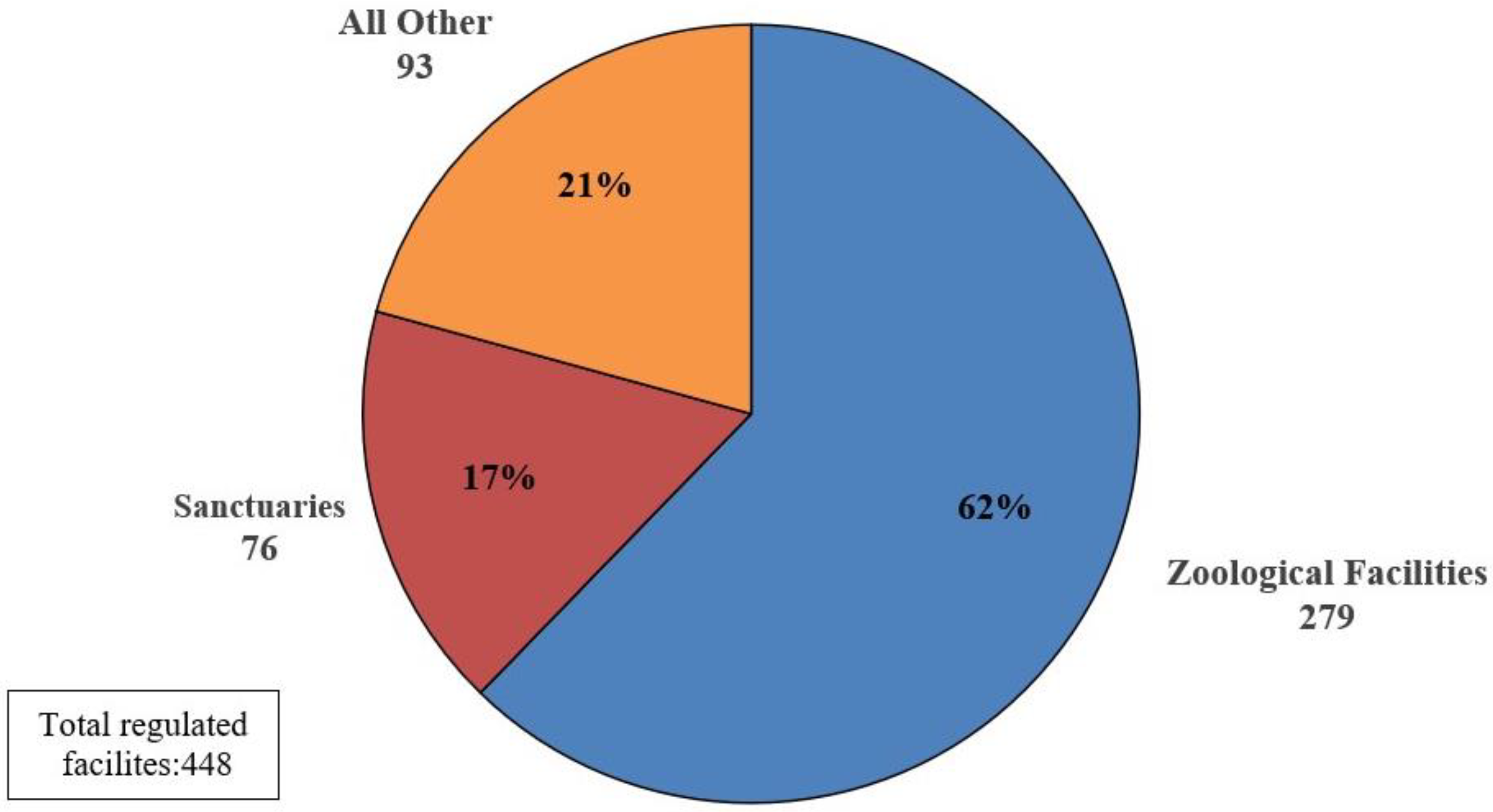
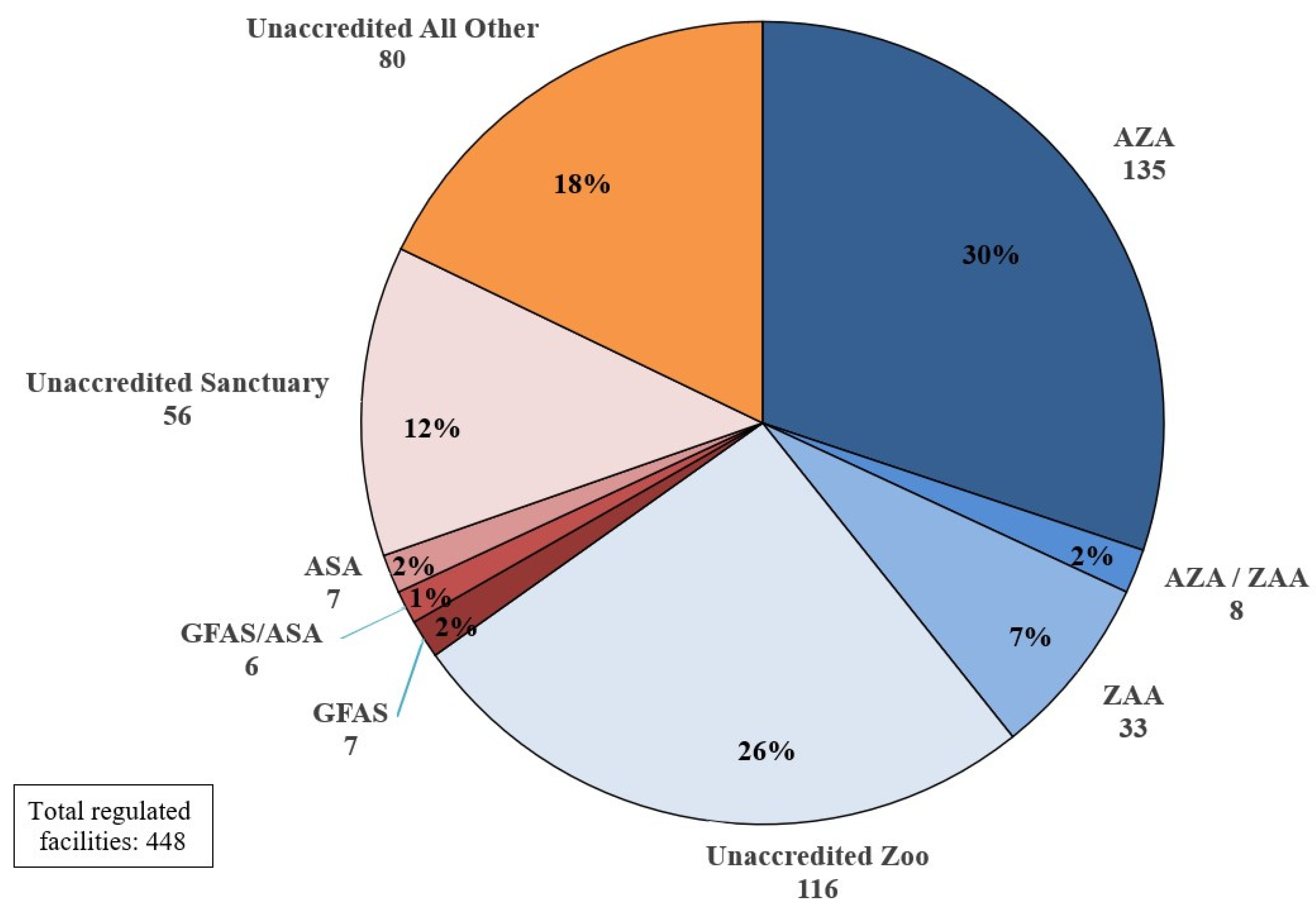
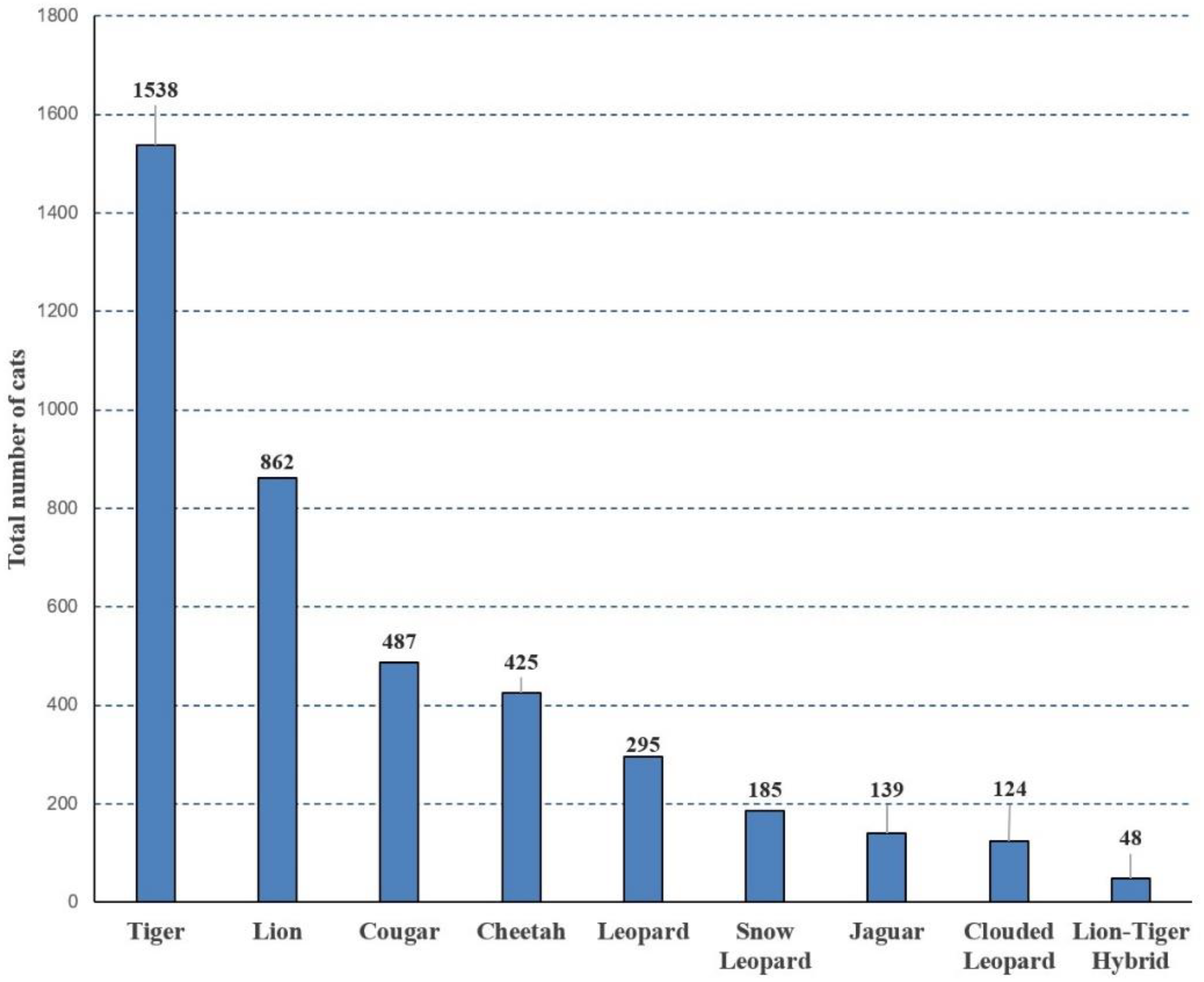
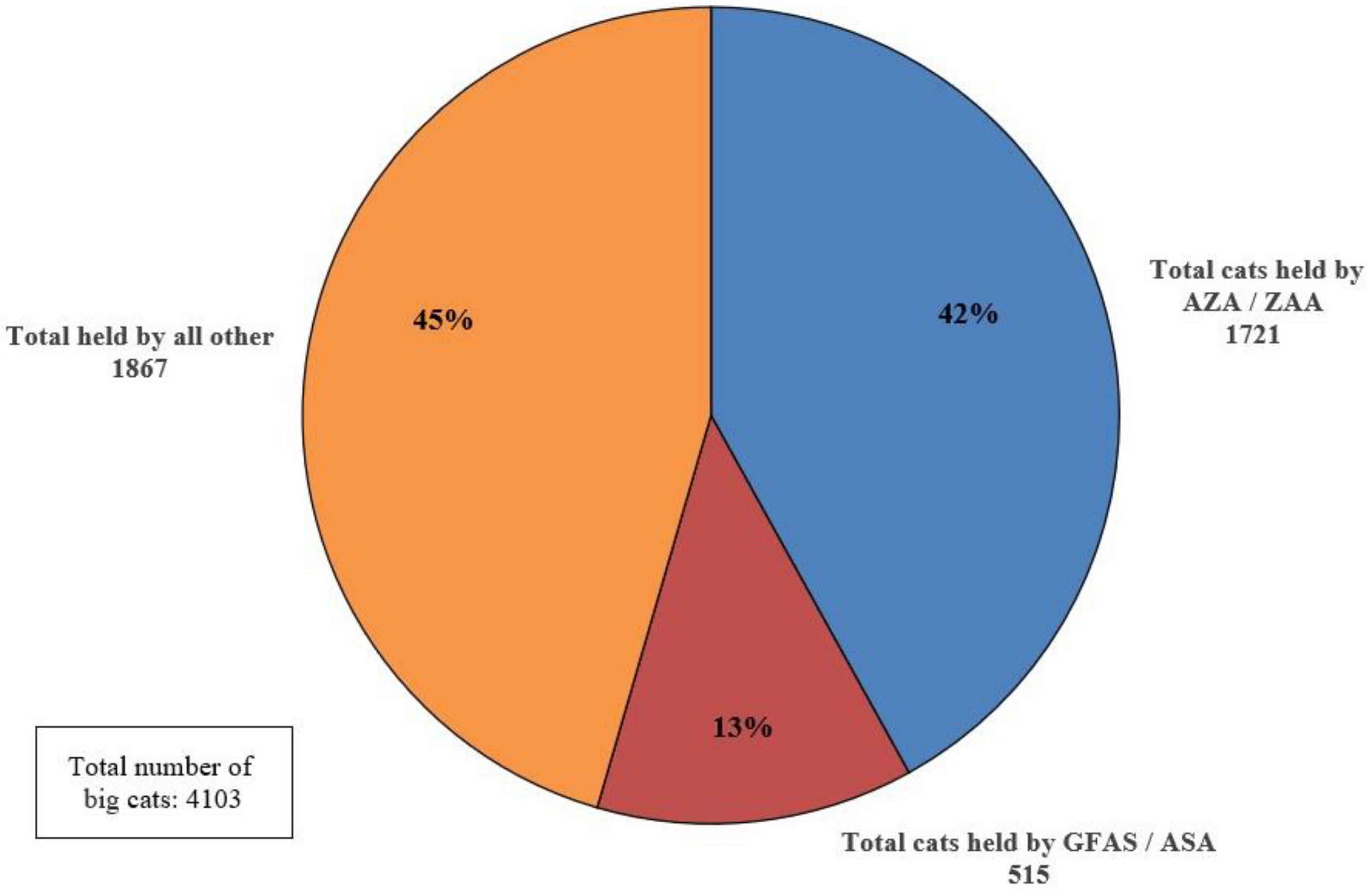
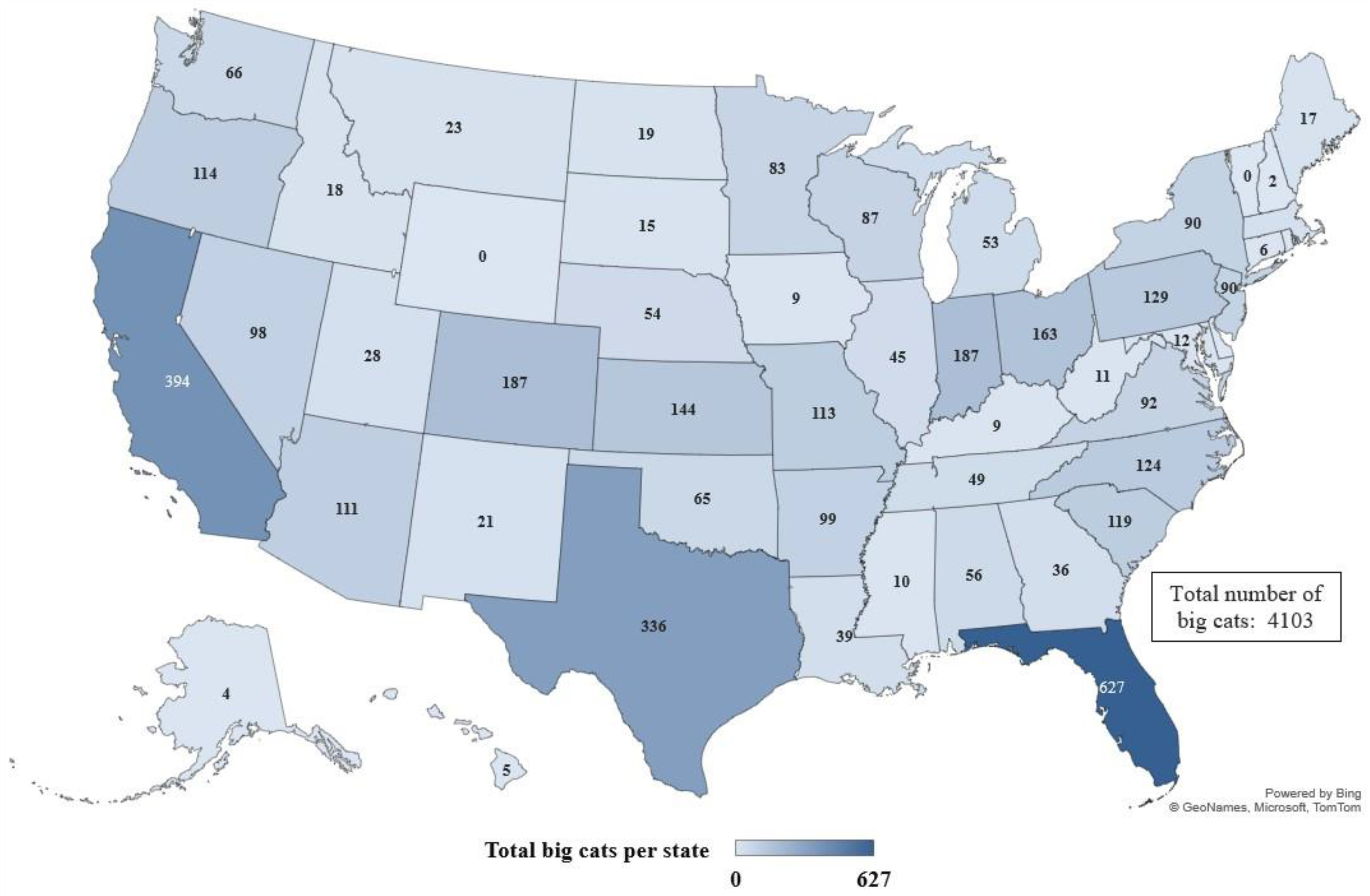
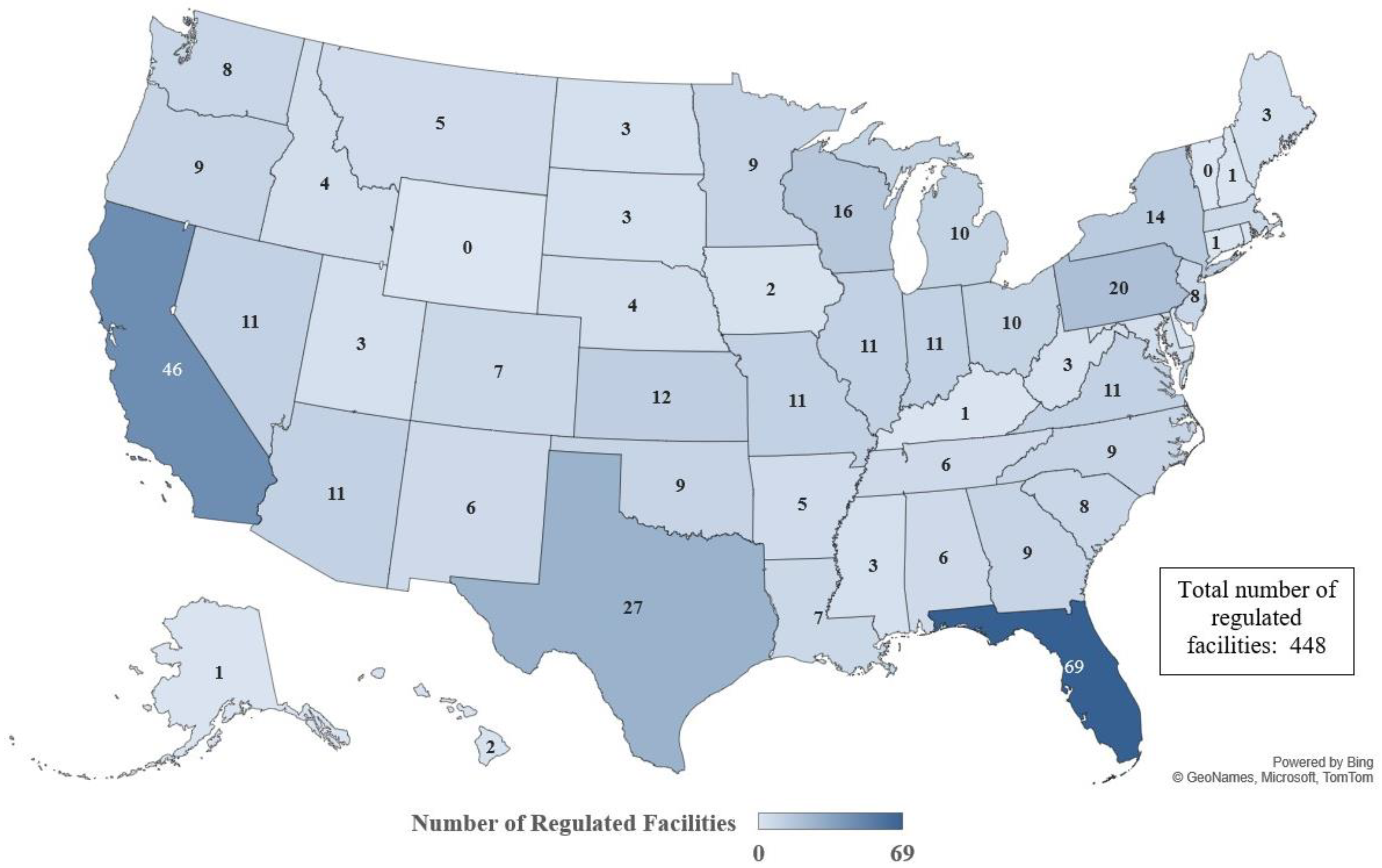
| Category | Definition |
|---|---|
| Alternate Mission Nonprofit | A nonprofit organization for which animal-related causes are not the primary mission but for which animal exhibition is a component |
| Amusement Park | An amusement park that includes an animal exhibition component |
| Camp/Resort | A vacation- or camp-style facility whose guest activities require them to maintain an exhibition license |
| Conservation Breeder | A business that breeds animals specifically for conservation programs that maintains an exhibition license for commercial support of the program |
| Educational Institution | A university or other place of learning with an animal collection for the purposes of student teaching and/or research that also maintains an exhibition license to make the collection available to the public |
| Entertainment/Outreach (animal-reliant) | A business that facilitates animal-based entertainment, education, or outreach programs held away from where the animals reside (e.g., birthday parties with animal presentations) |
| Entertainment/Outreach (not animal-reliant) | A business that does not exist for the purposes of animal exhibition that maintains an exhibition permit to include animals in their programming (e.g., magicians) |
| Mascot | A college or university that maintains an exhibition license for the purpose of having a live animal mascot |
| Museum | A permanent education facility that includes an on-site animal collection for exhibition and education programs |
| Nature Center | A facility specifically dedicated to educating the public about local ecosystems and wildlife that includes an on-site animal collection |
| Rescue/Rehabilitation | A wildlife rescue and rehabilitation facility that offers tours and on-site education programs with unreleasable animals |
| Production Work | A company that uses their animal collection in the pursuit of artistic projects (e.g., movies, theater, photography) |
| Park | A non-business area set aside for public recreation with an on-site animal component |
| Petting Zoo | A facility that allows the members of the public to interact directly with domestic, farm, and small exotic animals on-site |
| Retail Services | A business where animal exhibition is a supporting factor of primary business objectives (e.g., steak house, pet supply store, bed-and-breakfast) |
| Sanctuary | A business that provides a stationary collection of rescue animals with a permanent home and maintains an exhibition license to allow the public to visit or for commercial support of the facility |
| Zoological Facility | A business that maintains a stationary collection of exotic animals for the primary purpose of public exhibition |
| Unknown | Not enough information about this business is available for classification |
| Year | 2021 | 2016 1 (Chambers) | 2011 2 (Culver) | 2005 (Werner) |
|---|---|---|---|---|
| Number of facilities | 448 | 548 | N/A | N/A |
| Tiger | 1538 | 2330 | 2621 | 4692 |
| Lion | 862 | 1046 | 1024 | N/A |
| Cougar | 487 | 674 | 880 | N/A |
| Cheetah | 425 | 386 | 270 | N/A |
| Leopard | 295 | 367 | 562 | N/A |
| Snow Leopard | 185 | 164 | 170 | N/A |
| Jaguar | 139 | 140 | 141 | N/A |
| Clouded Leopard | 124 | N/A | 88 | N/A |
| Hybrids 3 | 48 | 37 | 32 | N/A |
| All | 4103 | 5144 | 5788 | 8977 |
Publisher’s Note: MDPI stays neutral with regard to jurisdictional claims in published maps and institutional affiliations. |
© 2021 by the author. Licensee MDPI, Basel, Switzerland. This article is an open access article distributed under the terms and conditions of the Creative Commons Attribution (CC BY) license (https://creativecommons.org/licenses/by/4.0/).
Share and Cite
Garner, R. A Census of Federally Regulated Big Cat Populations within the United States as of December 2020. J. Zool. Bot. Gard. 2021, 2, 517-530. https://doi.org/10.3390/jzbg2040037
Garner R. A Census of Federally Regulated Big Cat Populations within the United States as of December 2020. Journal of Zoological and Botanical Gardens. 2021; 2(4):517-530. https://doi.org/10.3390/jzbg2040037
Chicago/Turabian StyleGarner, Rachel. 2021. "A Census of Federally Regulated Big Cat Populations within the United States as of December 2020" Journal of Zoological and Botanical Gardens 2, no. 4: 517-530. https://doi.org/10.3390/jzbg2040037
APA StyleGarner, R. (2021). A Census of Federally Regulated Big Cat Populations within the United States as of December 2020. Journal of Zoological and Botanical Gardens, 2(4), 517-530. https://doi.org/10.3390/jzbg2040037





